-
![[Hippolyte Prosper Olivier LISSAGARAY]. History of the Commune of 1871 / Translated from the French of Lissagaray by Eleanor Marx Aveling. London: Reeved and Turner, 1886. pp.: [i-v] vi-xv [1] 2-500.](https://varshavskycollection.com/wp-content/uploads/2021/02/LIB-1110.2016-d-500x853.jpeg) Hardcover volume, collated in-8o, 21.9 c 14.6 cm, bound in half red morocco over red buckram by Palmer, Hove & Co. (Manchester), ruled in gilt, marbled end-papers, top edge gilt, spine with raised bands, ruled in gilt, gilt lettering; bookplate "Ex libris William John Robertson" with black ink ms dated 1922 to front pastedown. Insert paper clipping “In Memoriam” marked “D.W. 25.1.61.” Graphite ms to t.p.: “[assisted by Karl Marx]”. Pp.: [i-v] vi-xv [xvi blank], [1] 2-500; collation: ffl blank first and last, π8 A-2H8 2I2. Title-page: HISTORY | OF | THE COMMUNE OF 1871. | Translated from the French of | LISSAGARAY, | BY | ELEANOR MARX AVELING. | LONDON: | REEVES AND TURNER, 196 STRAND. | 1886.|| Contributors: Hippolyte Prosper-Olivier Lissagaray (French, 1838 – 1901) – author. Eleanor Marx [Aveling] (British, 1855 – 1898) – translator. William John Robertson (Canadian, 1846 – 1894) – provenance. The Russian translation of the same title: [LIB-1158.2016] Э. Лиссагарэ. История Парижской Коммуны в 1871 г. (Дешевая библиотека, № 274) / Пер. под ред. В. Базарова. — С.-Петербург: Знание, 1906.
Hardcover volume, collated in-8o, 21.9 c 14.6 cm, bound in half red morocco over red buckram by Palmer, Hove & Co. (Manchester), ruled in gilt, marbled end-papers, top edge gilt, spine with raised bands, ruled in gilt, gilt lettering; bookplate "Ex libris William John Robertson" with black ink ms dated 1922 to front pastedown. Insert paper clipping “In Memoriam” marked “D.W. 25.1.61.” Graphite ms to t.p.: “[assisted by Karl Marx]”. Pp.: [i-v] vi-xv [xvi blank], [1] 2-500; collation: ffl blank first and last, π8 A-2H8 2I2. Title-page: HISTORY | OF | THE COMMUNE OF 1871. | Translated from the French of | LISSAGARAY, | BY | ELEANOR MARX AVELING. | LONDON: | REEVES AND TURNER, 196 STRAND. | 1886.|| Contributors: Hippolyte Prosper-Olivier Lissagaray (French, 1838 – 1901) – author. Eleanor Marx [Aveling] (British, 1855 – 1898) – translator. William John Robertson (Canadian, 1846 – 1894) – provenance. The Russian translation of the same title: [LIB-1158.2016] Э. Лиссагарэ. История Парижской Коммуны в 1871 г. (Дешевая библиотека, № 274) / Пер. под ред. В. Базарова. — С.-Петербург: Знание, 1906. -
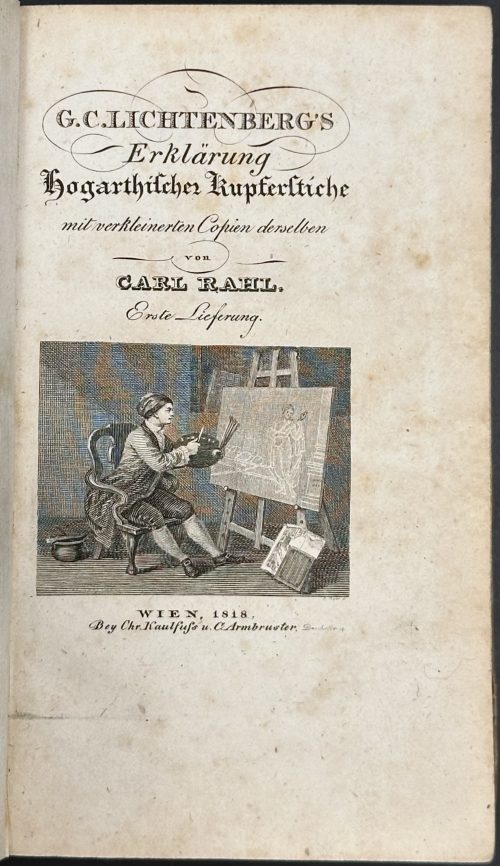 Three hardcover volumes, in-12mo, 16.2 x 10.6 cm each, uniformly bound in quarter brown cloth over marbled boards, all margins marbled, gilt lettering to spine; plus an oblong volume of similar binding, 24.5 x 39.5 cm, with 88 engraved plates by Riepenhausen after Hogarth (83 pp, unnumbered). Catalogue raisonné of William Hogarth's engravings, published by Carl Armbruster in Vienna and Dieterichsche Buchhandlung in Göttingen. A detailed explanation of Hogarth's prints divided in 14 parts. Vol. 1.
Three hardcover volumes, in-12mo, 16.2 x 10.6 cm each, uniformly bound in quarter brown cloth over marbled boards, all margins marbled, gilt lettering to spine; plus an oblong volume of similar binding, 24.5 x 39.5 cm, with 88 engraved plates by Riepenhausen after Hogarth (83 pp, unnumbered). Catalogue raisonné of William Hogarth's engravings, published by Carl Armbruster in Vienna and Dieterichsche Buchhandlung in Göttingen. A detailed explanation of Hogarth's prints divided in 14 parts. Vol. 1.- C. G. Lichtenberg’s Ausführliche Erklärung der Hogarthischen Kupferstiche, mit verkleinerten Copien derselben von Carl Rahl. Erste Lieferung. Wien, 1818. Bey Chr. Kaulfuß und C. Armbruster. Gedruckt bey Anton Strauß. [i-v] vi-xxxvi, [1-3] 4-136, plus engraved t.p.
- C. G. Lichtenberg’s Ausführliche Erklärung der Hogarthischen Kupferstiche, mit verkleinerten Copien derselben von Carl Rahl. Zweite Lieferung. Wien, 1818. Bey Chr. Kaulfuß und C. Armbruster. Gedruckt bey Anton Strauß. [i-iii] iv-viii [2] 11-207 [1 blank], plus engraved t.p.
- C. G. Lichtenberg’s Ausführliche Erklärung der Hogarthischen Kupferstiche, mit verkleinerten Copien derselben von Carl Rahl. Dritte Lieferung. Wien, 1818. Bey Chr. Kaulfuß und C. Armbruster. Gedruckt bey Anton Strauß. [i-iii] iv-vi [3] 10-215 [1 blank], plus engraved t.p.
- C. G. Lichtenberg’s Ausführliche Erklärung der Hogarthischen Kupferstiche, mit verkleinerten Copien derselben von Carl Rahl. Vierte Lieferung. Wien, 1818. Bey Chr. Kaulfuß und C. Armbruster. Gedruckt bey Anton Strauß. [1-5] 6-180 [1 blank], plus engraved t.p.
- C. G. Lichtenberg’s Ausführliche Erklärung der Hogarthischen Kupferstiche, mit verkleinerten Copien derselben von Carl Rahl. Fünste Lieferung. Wien, bey Carl Armbruster 1819. Gedruckt bey Anton Strauß. [1-3] 4-144, plus engraved t.p.
- C. G. Lichtenberg’s Ausführliche Erklärung der Hogarthischen Kupferstiche, mit verkleinerten Copien derselben von Carl Rahl. Sechste Lieferung. Mit zufåßen nach den schriften der englischen Erflårer. Wien, bey Carl Armbruster 1819. Gedruckt bey Anton Strauß. [i-iii] iv-x [2] 13-100, plus engraved t.p.
- C. G. Lichtenberg’s Ausführliche Erklärung der Hogarthischen Kupferstiche, mit verkleinerten Copien derselben von Carl Rahl. Siebente und achte Lieferung. Mit zufåßen nach den Schriften der englischen Erflårer. Wien, bey Carl Armbruster 1820. Gedruckt bey Anton Strauß. [1-8] 9-191, plus engraved t.p.
- C. G. Lichtenberg’s Ausführliche Erklärung der Hogarthischen Kupferstiche, mit verkleinerten Copien derselben von Carl Rahl. Neunte und zehnte Lieferung. Mit zufåßen nach den Schriften der englischen Erflårer. Wien, bey Carl Armbruster 1823. Gedruckt bey Anton Strauß. [1-7] 8-168, plus engraved t.p.
- C. G. Lichtenberg’s Erklärung der Hogarthischen Kupferstiche, mit verkleinerten aber vollständigen Copien derselben von E. Riepenhausen. Eilfte Lieferung mit zufåßen nach den schriften der englischen Erflårer. Göttingen in der Dieterichsche Buchhandlung 1809. [1-3] 4-81 [82 blank].
- C. G. Lichtenberg’s Ausführliche Erklärung der Hogarthischen Kupferstiche, mit verkleinerten aber vollständigen Copien derselben von E. Riepenhausen fortgefeßt vom Berausgeber der fechsten Lieferung mit Benußung der englischen Erflårer. Zwölfte Lieferung. Göttingen in der Dieterichsche Buchhandlung 1816. [i-iii] iv [1-3] 4-76.
- J. P. Lyser’s Ausführliche Erklärung der Hogarthischen Kupferstiche, mit verkleinerten aber vollständigen Copien derselben von E. Riepenhausen. Dreizehnte Lieferung Göttingen in der Dieterichsche Buchhandlung 1833. [i-v] vi-xii, [1-3] 4-117 [118].
- Dr. le Petit’s Ausführliche Erklärung der Hogarthischen Kupferstiche, mit verkleinerten aber vollständigen Copien derselben von E. Riepenhausen, Berausgeber Karl Gutzkow. Vierzehnte Lieferung. Göttingen in der Dieterichsche Buchhandlung 1835. [i-iii] iv-xvi, [1-3] 4-132.
-
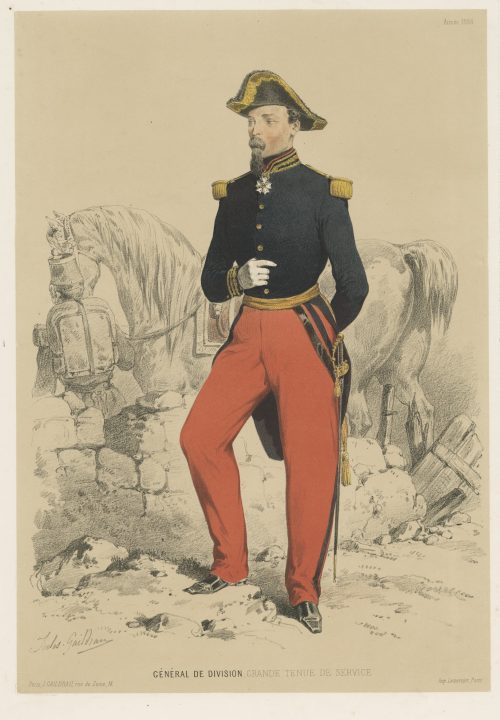 Chromolithography on thick wove paper, 473 x 315 mm sheet, 372 x 260 mm image, black ink stamp “5050” to reverse. Signed on stone "Jules Gaildrau"; below centre: "GÉNERAL DE DIVISION, GRANDE TENUE DE SERVICE"; Bottom left: "Paris, J. Gaildrau, rue de Seine, 16"; right: "Imp. Lemercier, Paris." Joseph Lemercier (French, 1803 – 1887) – printer. Jules Gaildrau (French, 1816 – 1898) – artist.
Chromolithography on thick wove paper, 473 x 315 mm sheet, 372 x 260 mm image, black ink stamp “5050” to reverse. Signed on stone "Jules Gaildrau"; below centre: "GÉNERAL DE DIVISION, GRANDE TENUE DE SERVICE"; Bottom left: "Paris, J. Gaildrau, rue de Seine, 16"; right: "Imp. Lemercier, Paris." Joseph Lemercier (French, 1803 – 1887) – printer. Jules Gaildrau (French, 1816 – 1898) – artist. -
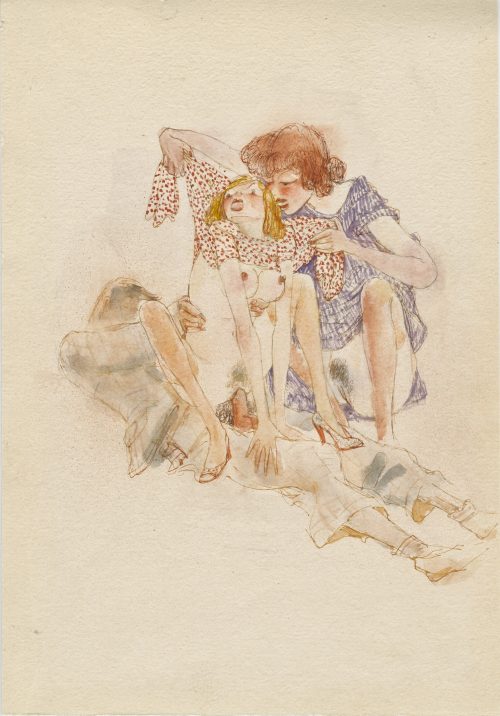 Watercolour on thick wove paper, unsigned. Attributed to Otto Rudolf Schatz (Austrian, 1900 – 1961). Size: 305 x 212 mm.
Watercolour on thick wove paper, unsigned. Attributed to Otto Rudolf Schatz (Austrian, 1900 – 1961). Size: 305 x 212 mm. -
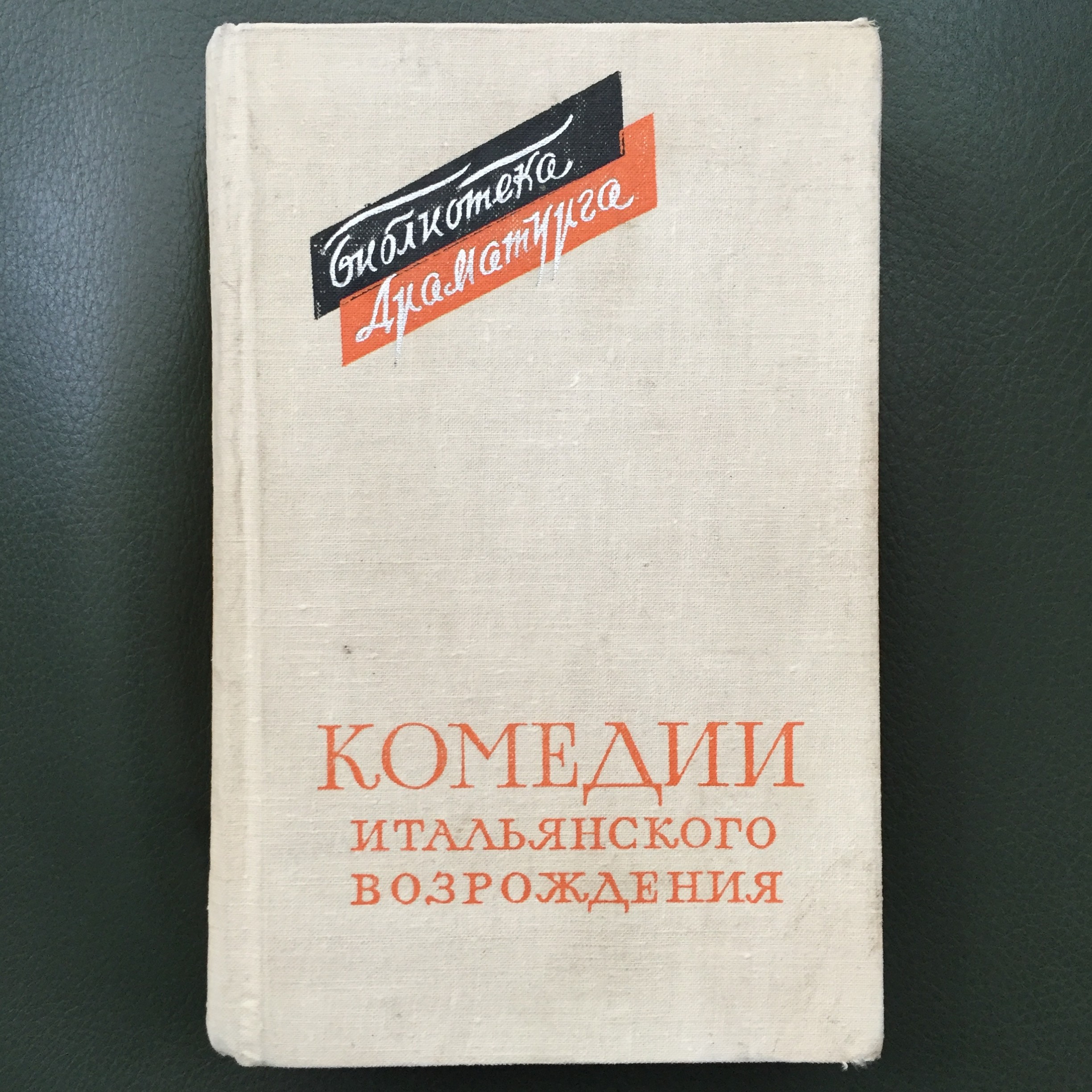
Комедии итальянского возрождения. Пер. с итал. - М.: Искусство, 1965. Составление и вступительная статья Г. Бояджиева. Редакция переводов и примечания Н. Томашевского. Серия: "Библиотека драматурга".
Лодовико Ариосто: Комедия о сундуке. Подмененные. Перевод Н. Георгиевской.
Бернардо Довици: Коландрия. Перевод А. Габричевского.
Никколо Макиавелли: Мандрагора. Перевод Н. Ракинта.
Пьетро Аретино: Комедия о придворных нравах. Философ. Перевод А. Габричевского.
Джордано Бруно: Неаполитанская улица. Перевод Я. Емельянова.
-
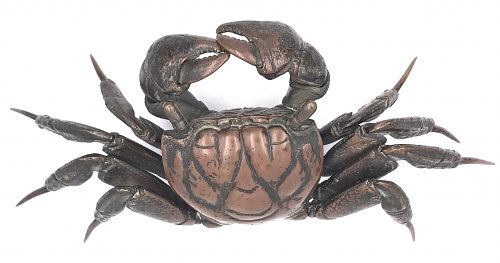 Jizai okimono bronze articulated model of a crab. Japan, Meiji period(1868-1912). Size: Body: 6.5 x 6 cm. Total: 23 x 11 cm. Weight: 762 g
Jizai okimono bronze articulated model of a crab. Japan, Meiji period(1868-1912). Size: Body: 6.5 x 6 cm. Total: 23 x 11 cm. Weight: 762 g -
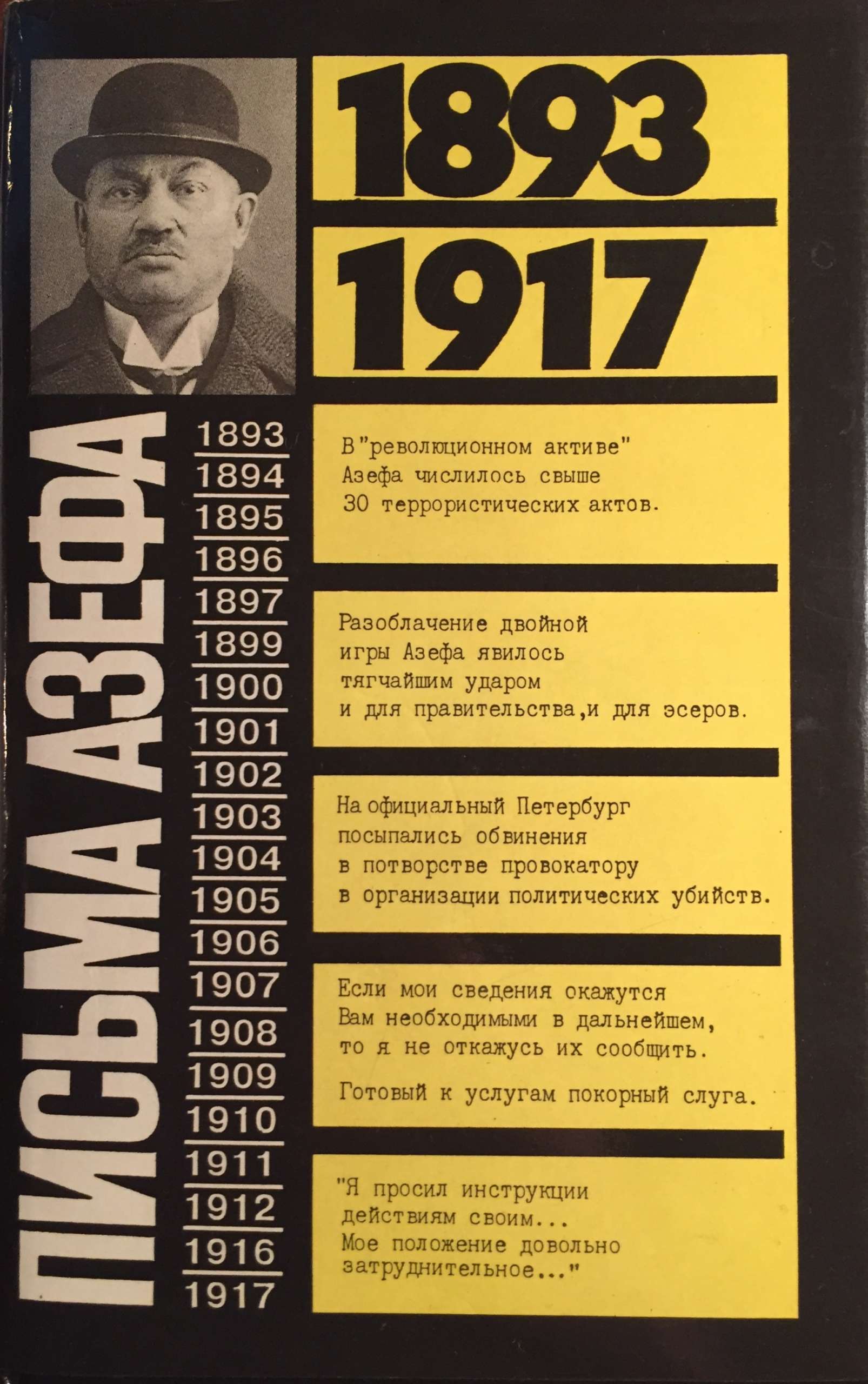 Hardcover volume 20.7 x 13.4 cm, bound in black buckram with blind and grey lettering to front and grey lettering to spine, in a pictorial dust jacket, yellow pictorial endpapers, pp.: [2] 3-287 [1], collated in 16mo, 1-916, 144 leaves, 288 pages. Title-page: ПИСЬМА АЗЕФА | — | 1893 – 1917 | — | [blank] | {publisher’s device} | МОСКВА | «ТЕРРА» — «TERRA» | 1994 || Print run: 10,000 copies. Азеф, Евгений Филиппович [Евно Фишелевич], [Azef, Yevno] (Jewish-Russian-German, 1869 – 1918) Павлов, Дмитрий Борисович (Russian, b. 1954) Перегудова, Зинаида Ивановна (Russian, b. 1934)
Hardcover volume 20.7 x 13.4 cm, bound in black buckram with blind and grey lettering to front and grey lettering to spine, in a pictorial dust jacket, yellow pictorial endpapers, pp.: [2] 3-287 [1], collated in 16mo, 1-916, 144 leaves, 288 pages. Title-page: ПИСЬМА АЗЕФА | — | 1893 – 1917 | — | [blank] | {publisher’s device} | МОСКВА | «ТЕРРА» — «TERRA» | 1994 || Print run: 10,000 copies. Азеф, Евгений Филиппович [Евно Фишелевич], [Azef, Yevno] (Jewish-Russian-German, 1869 – 1918) Павлов, Дмитрий Борисович (Russian, b. 1954) Перегудова, Зинаида Ивановна (Russian, b. 1934)ISBN: 5-85255-395-6. Azef Letters (Rus).
-
 Yamagane tsuba of round form with design of a 14 petal chrysanthemum (kiku) in cast openwork (sukashi), with slightly raised rounded rim. Early Muromachi period (1393-1457). Size: Height: 64.5 mm; Width: 64.0 mm; Thickness at seppa-dai: 4.1 mm; Weight: 52.5 g. Provenance: Sasano collection (though not illustrated in the book 'Sasano: Japanese Sword Guard Masterpieces from the Sasano Collection, 1994', which only covers tsuba made of iron). Wooden box (tomobako) with inscription (hakogaki) by Sasano Masayuki. References: Illustrated on p. 140 at Tosogu: Treasure of the samurai by Graham Gemmell in the article Muromachi period tsuba by Robin Peverett, London, 1991, pp. 131-145. Sold at Sotheby's, London, Thursday 10 April 1997 Sotheby's, London, 1997 [Japanese Swords and Tsuba from the Professor A.Z. Freeman and the Phyllis Sharpe Memorial collections], p. 16: "A ko-kinko bronze Tsuba, early Muromachi period (1393-1453) of circular form, with raised rounded rim, pierced with kiku petals and with a small elongated kozuka-hitsu, the work appearing to be cast and finished by hand. 6.4cm, thickness at centre 4.15mm, at rim 4.8mm. With a Tomobako, bearing a hakogaki by Masayuki Sasano, with rating Shu. Estimated: £1,000-1,500." Hakogaki (courtesy M. Sesko): 古金工 鐔 Ko-Kinkō tsuba 菊花透 無銘 山銅地透 時代 室町前期 古雅入念 秀作 昭和戊辰年伏月 素心鑑 kikka-sukashi, mumei yamagane, ji-sukashi jidai Muromachi-zenki koga nyūnen, shūsaku Showa tsuchinoe-tatsudoshi fukugetsu Soshinkan Kikka-sukashi, unsigned. Of yamagane and with ji-sukashi. Era is early Muromachi period. Excellent and carefully made work of classical elegance. June in the year of the dragon of the Shōwa era (1988) Soshinkan (pen name of Sasano Masayuki).
Yamagane tsuba of round form with design of a 14 petal chrysanthemum (kiku) in cast openwork (sukashi), with slightly raised rounded rim. Early Muromachi period (1393-1457). Size: Height: 64.5 mm; Width: 64.0 mm; Thickness at seppa-dai: 4.1 mm; Weight: 52.5 g. Provenance: Sasano collection (though not illustrated in the book 'Sasano: Japanese Sword Guard Masterpieces from the Sasano Collection, 1994', which only covers tsuba made of iron). Wooden box (tomobako) with inscription (hakogaki) by Sasano Masayuki. References: Illustrated on p. 140 at Tosogu: Treasure of the samurai by Graham Gemmell in the article Muromachi period tsuba by Robin Peverett, London, 1991, pp. 131-145. Sold at Sotheby's, London, Thursday 10 April 1997 Sotheby's, London, 1997 [Japanese Swords and Tsuba from the Professor A.Z. Freeman and the Phyllis Sharpe Memorial collections], p. 16: "A ko-kinko bronze Tsuba, early Muromachi period (1393-1453) of circular form, with raised rounded rim, pierced with kiku petals and with a small elongated kozuka-hitsu, the work appearing to be cast and finished by hand. 6.4cm, thickness at centre 4.15mm, at rim 4.8mm. With a Tomobako, bearing a hakogaki by Masayuki Sasano, with rating Shu. Estimated: £1,000-1,500." Hakogaki (courtesy M. Sesko): 古金工 鐔 Ko-Kinkō tsuba 菊花透 無銘 山銅地透 時代 室町前期 古雅入念 秀作 昭和戊辰年伏月 素心鑑 kikka-sukashi, mumei yamagane, ji-sukashi jidai Muromachi-zenki koga nyūnen, shūsaku Showa tsuchinoe-tatsudoshi fukugetsu Soshinkan Kikka-sukashi, unsigned. Of yamagane and with ji-sukashi. Era is early Muromachi period. Excellent and carefully made work of classical elegance. June in the year of the dragon of the Shōwa era (1988) Soshinkan (pen name of Sasano Masayuki). -
 Well-forged iron plate of round shape (maru-gata) is decorated with water weeds or arabesque (karakusa) in flat brass inlay (hira-zōgan) all over and eight family crests (mon) of round form in cast brass with delicate linear carving (kebori) and openwork (sukashi). Crests represent: [at 9 hours] three counter-clockwise commas or swirls (tomoe); [at 10:30] plum blossom (ume); [at 12:00, 1:130, and 7:30] - stylized flower made by cutting out five suhama symblos (flower-shaped suhama); [at 3:00] bellflower (kikyō); [at 4:30] seven-star crest (shichiyō-mon); [at 6:00] cherry blossom (sakura). Brass-trimmed ryo-hitsu. Copper sekigane. Yoshirō school. Momoyama or early Edo period, end of the 16th to first half of the 17th century (1574-1650). Inscription on seppa-dai: 八幡 - Hachiman. Size: height 89.6 mm, width 89.3 mm, thickness at seppa-dai 3,0 mm. Weight 129.7 g. NBTHK certificate № 4007685, June 27, 2015: HOZON (Worthy of Preservation). As for the inscription, Nihonto Message Board blog discussion provides the following explanation of the inscription: "An expression of conviction as to being the best under the sun". On the other hand, there may be more in this confluence of symbols: the tomoe crest at 9:00 is "the kamon of Hachiman, the war god" [Family Crests of Japan; Stone Bridge Press, Berkeley, CA, 2007, p. 108]. The character 八 in the inscription cut stronger than the other kanji, and may be by a different hand in different time. 八 (hachi, eight): "The numeral eight was appreciated because its shape broadens toward the bottom, symbolizing eternal expansion" [ibid, p. 119]. It may be said that this tsuba is dedicated to Hachiman. Other crests (suhama, bellflower, seven-stars, plum and cherry blossoms) collectively allude to "good old times" when Fijiwara and Taira clans were in full bloom. Markus Sesko believes that the inscriptions reads: Hachiman: "the inscription is/was HACHIMAN (八幡), the God of War and a relatively popular inscription for tsuba, swords and armor." Elliott Long and Robert Haynes provide the following explanation of the inscription: "...hachi is correct and represents the name of the HACHI SHRINE. The inscription reads 'YAWATA' which is the name of the mountain in Mino Province where the HACHI Shrine is located". Details on Hachiman Shrine in Yawata (八幡市) can be found elsewhere, including Historical and geographical dictionary of Japan by Edmond Papinot. Van Ham auction house provides the following description: MON-SUKASHI TSUBA. MARUGATA. Japan. Momoyama period. Yoshiro school. Iron with inlays of brass. In hira-zogan technique with kebori engraving eight different family emblems (mon). An old inscription is dedicated to the deity Hachiman. D.4.5mm, Ø 8.3cm. Condition A/B. Supplement: Wooden box and NBTHK certificate.
Well-forged iron plate of round shape (maru-gata) is decorated with water weeds or arabesque (karakusa) in flat brass inlay (hira-zōgan) all over and eight family crests (mon) of round form in cast brass with delicate linear carving (kebori) and openwork (sukashi). Crests represent: [at 9 hours] three counter-clockwise commas or swirls (tomoe); [at 10:30] plum blossom (ume); [at 12:00, 1:130, and 7:30] - stylized flower made by cutting out five suhama symblos (flower-shaped suhama); [at 3:00] bellflower (kikyō); [at 4:30] seven-star crest (shichiyō-mon); [at 6:00] cherry blossom (sakura). Brass-trimmed ryo-hitsu. Copper sekigane. Yoshirō school. Momoyama or early Edo period, end of the 16th to first half of the 17th century (1574-1650). Inscription on seppa-dai: 八幡 - Hachiman. Size: height 89.6 mm, width 89.3 mm, thickness at seppa-dai 3,0 mm. Weight 129.7 g. NBTHK certificate № 4007685, June 27, 2015: HOZON (Worthy of Preservation). As for the inscription, Nihonto Message Board blog discussion provides the following explanation of the inscription: "An expression of conviction as to being the best under the sun". On the other hand, there may be more in this confluence of symbols: the tomoe crest at 9:00 is "the kamon of Hachiman, the war god" [Family Crests of Japan; Stone Bridge Press, Berkeley, CA, 2007, p. 108]. The character 八 in the inscription cut stronger than the other kanji, and may be by a different hand in different time. 八 (hachi, eight): "The numeral eight was appreciated because its shape broadens toward the bottom, symbolizing eternal expansion" [ibid, p. 119]. It may be said that this tsuba is dedicated to Hachiman. Other crests (suhama, bellflower, seven-stars, plum and cherry blossoms) collectively allude to "good old times" when Fijiwara and Taira clans were in full bloom. Markus Sesko believes that the inscriptions reads: Hachiman: "the inscription is/was HACHIMAN (八幡), the God of War and a relatively popular inscription for tsuba, swords and armor." Elliott Long and Robert Haynes provide the following explanation of the inscription: "...hachi is correct and represents the name of the HACHI SHRINE. The inscription reads 'YAWATA' which is the name of the mountain in Mino Province where the HACHI Shrine is located". Details on Hachiman Shrine in Yawata (八幡市) can be found elsewhere, including Historical and geographical dictionary of Japan by Edmond Papinot. Van Ham auction house provides the following description: MON-SUKASHI TSUBA. MARUGATA. Japan. Momoyama period. Yoshiro school. Iron with inlays of brass. In hira-zogan technique with kebori engraving eight different family emblems (mon). An old inscription is dedicated to the deity Hachiman. D.4.5mm, Ø 8.3cm. Condition A/B. Supplement: Wooden box and NBTHK certificate. -
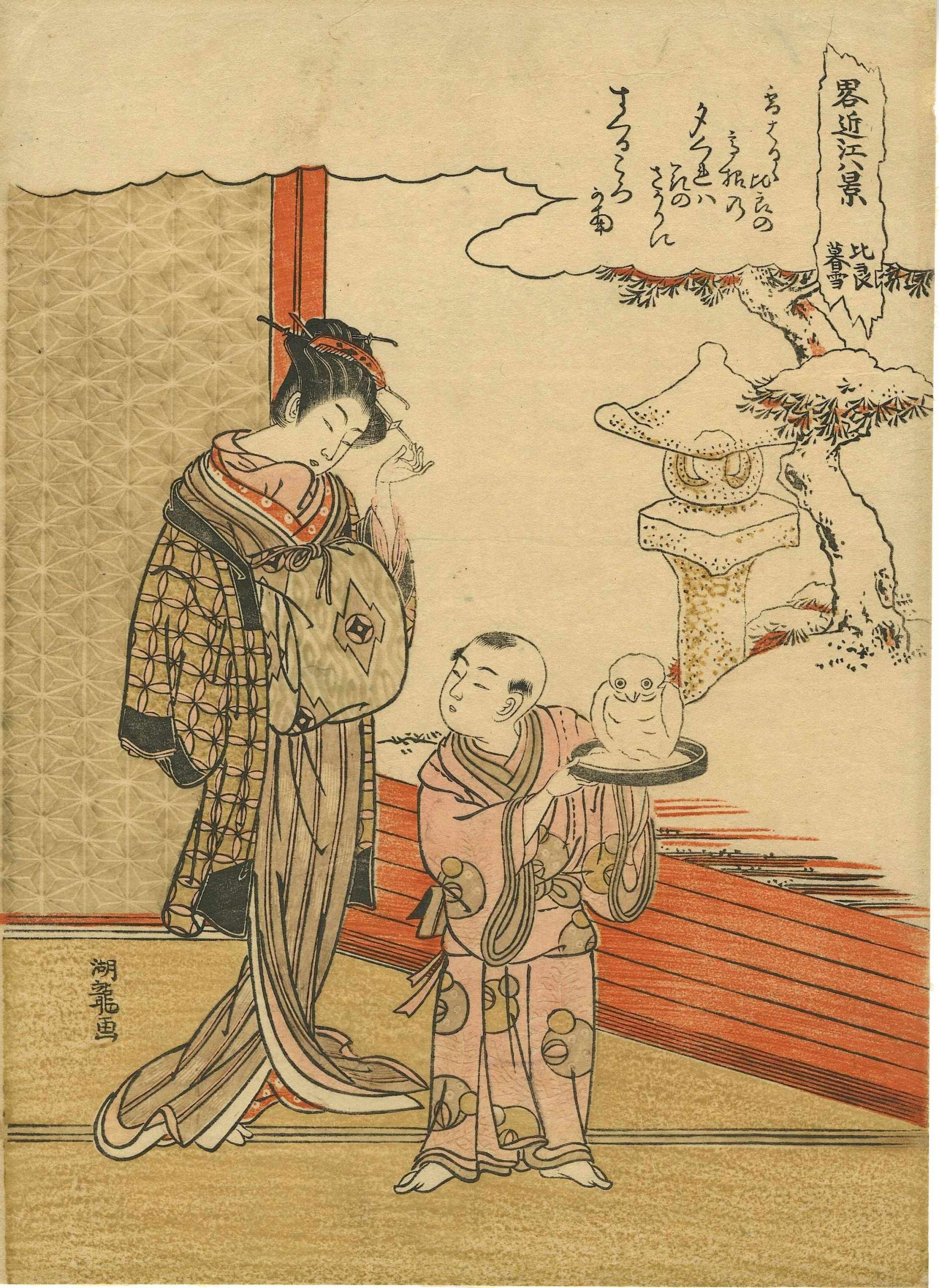 Evening Snow on Mount Hira (Hira no bosetsu), from the series Eight Views of Ōmi in Modern Guise (Ryaku Ōmi hakkei, (略近江八景). About 1773–75 (An'ei 2–4). Artist: Isoda Koryūsai (Japanese, 1735–1790) CATALOGUE RAISONNÉ: Hockley 2003, p. 202, #F-21-1 DIMENSIONS: Vertical chûban; 26 x 19.3 cm (10 1/4 x 7 5/8 in.)Signed: Koryû ga [湖竜画]
Evening Snow on Mount Hira (Hira no bosetsu), from the series Eight Views of Ōmi in Modern Guise (Ryaku Ōmi hakkei, (略近江八景). About 1773–75 (An'ei 2–4). Artist: Isoda Koryūsai (Japanese, 1735–1790) CATALOGUE RAISONNÉ: Hockley 2003, p. 202, #F-21-1 DIMENSIONS: Vertical chûban; 26 x 19.3 cm (10 1/4 x 7 5/8 in.)Signed: Koryû ga [湖竜画] -
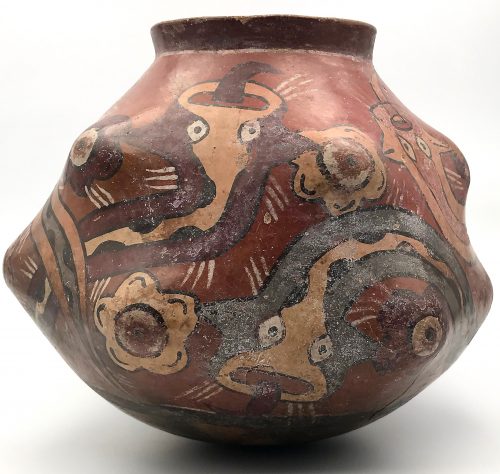
Pre-Columbian, South Coast of Peru, Nazca, ca. 22- BCE - 125 CE.Polychrome vessel of organic, phytomorphic form and thin walls finely painted with six slithering serpents and protruding floral motifs in hues of red, orange, cream, black, grey, and white.
Chips of base and rim. Pressure fissures on and a bit above the base. Surface wear commensurate with age.
Size: Diameter: 19 cm; Height: 16 cm; Mouth diameter: 8.5 cm.
-

Iron tsuba of circular form with design of pine trees (matsu) and monkey toys (kukurizaru) in openwork (ko-sukashi). Ko-Katchushi school.
Raised rim (mimi) with iron bones (tekkotsu). Size: Diameter: 99.5 mm; Thickness: 2.1 mm at centre; 4.3 mm at the rim.Early Muromachi period: 15th century (Kakitsu - Bun'an era, 1441 - 1449).
-
 Utagawa Kunisada [歌川 国貞]; a.k.a. Utagawa Toyokuni III [三代歌川豊国] (Japanese, 1786 – 1865).
Utagawa Kunisada [歌川 国貞]; a.k.a. Utagawa Toyokuni III [三代歌川豊国] (Japanese, 1786 – 1865).Signed: Toyokuni ga [豊国 画] in a red toshidama cartouche.
Publisher: Kojimaya Jūbei (c. 1797-1869), seal: Hanmoto, Jū [板元, 十] (Marks 19-043 | 264c).
Double nanushi censor seals: Mera & Watanabe – Kaei 4 (1851).
Uncut fan print (uchiwa-e), 298 x 228 mm depicting a young woman adjusting her hairpin and holding a portable lantern (andon) on a marine background with the full moon, nearby boats and distant cormorant fishers. -
 Artist: Utagawa Kunisada [歌川 国貞], a.k.a. Utagawa Toyokuni III [三代 歌川 豊国] (Japanese, 1786 – 1865). Signed: Toyokuni ga [豊国 画] in a red toshidama cartouche Block carver: Yokokawa Takejirō [横川竹二郎] (Japanese, fl. 1845 – 1863), seal: 彫竹 – Hori Take. Publisher: Ibaya Senzaburō [伊場屋仙三郎] (Japanese, fl. c. 1845 – 1847). Combined date and kiwame seal: Ansei 5 (II-XII/1858). Size: Untrimmed fan print (uchiwa-e), 300 x 232 mm.
Artist: Utagawa Kunisada [歌川 国貞], a.k.a. Utagawa Toyokuni III [三代 歌川 豊国] (Japanese, 1786 – 1865). Signed: Toyokuni ga [豊国 画] in a red toshidama cartouche Block carver: Yokokawa Takejirō [横川竹二郎] (Japanese, fl. 1845 – 1863), seal: 彫竹 – Hori Take. Publisher: Ibaya Senzaburō [伊場屋仙三郎] (Japanese, fl. c. 1845 – 1847). Combined date and kiwame seal: Ansei 5 (II-XII/1858). Size: Untrimmed fan print (uchiwa-e), 300 x 232 mm.A young woman adjusting her hairpin on a balcony during the Tanabata festival, as inscribed on the white folding fan: [七夕] (Tanabata).
Inscription on the blue book (print title): Early autumn [はつ秋や] (hatsu akiya), inscription on the purple book (series title): Short love songs, second volume [端唄の意 二編] (Hauta no kokoro nihen). According to Marks (2010), Hauta no kokoro nihen series of fan prints was published by Ibaya in 1858 (p. 267|P6871).
The series refers to love songs of a certain type popular in late Edo. They were performed with the accompaniment of a shamisen, “Seven herbs of autumn, the song of the insects is not heard; the bodies of lightning bugs are burnt, and the precious writings of love are getting thinner like the song of the insects as I am waiting for you. So, on an early autumn evening, I spot the glitter of a lightning bug that lingered among the autumn grasses, and while listening to the pine cricket, I am singing with my heart troubled by love". [Tokyo National Museum; translation provided by Elena Varshavsky].Tanabata [たなばた] or [七夕] – meaning "Evening of the seventh", also known as the Star Festival [星祭] (Hoshi matsuri) – is a Japanese festival originating from the Chinese Qixi Festival. One popular Tanabata custom is to write one's wishes on a piece of paper and hang that piece of paper on a specially erected bamboo tree, in the hope that the wishes become true.
-
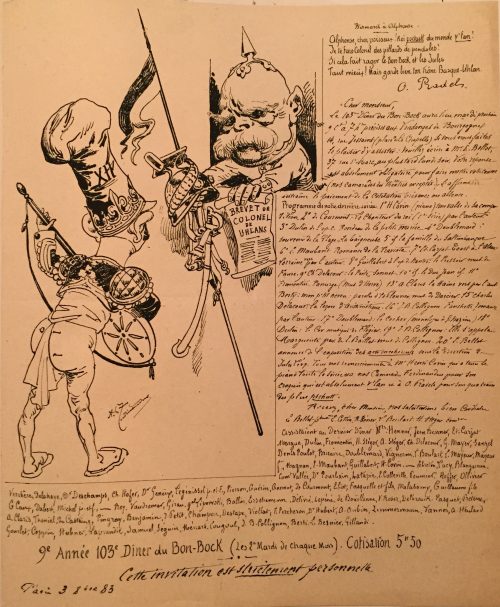
The 103rd Bon Bock Dinner Invitation
Artist: François Avenet a.k.a. Alexandre Ferdinandus (French, 1850 – 1888).
Cher monsieur, Le 103ème Dîner du Bon-Bock aura lieu mardi prochain / à 7h précises aux Vendanges de Bourgognel / 14, rue Jessaint (place de la Chapelle). Si vous nous faites le plaisir d’y assister : Veuillez écrire à Mr. E. Bellot, / 37 rue St Marc, au plus tard lundi soir. Votre réponse / est absolument obligatoire pour faire mettre votre couvert (nos camarades des théâtres exceptés.) L’affirmative entraine le paiement de la cotisation présence ou absence. / Programme de notre dernière soirée. 1e H Covin (piano) une valse de sa compo- / sition. 2e de Courment : Le Chanteur du roi (1ère série) par l’auteur. / 3e Dulin de l’o.p.e. Rondeau de la petite mariée 4e Doublemard : / souvenir de la Plage La baigneuse 5e "la famille des Saltimbanque" / 6e C. Maubant Romance de la Traviata. 7e Ct. Carjat Toast à l’Alsace-/Lorraine vers par l’auteur. 8e Guillabert de l’ap. de Nantes : le Pressoir mud. de / Faure . 9e Ch. Delacour : le Poete, Sonnet. 10e if. le Duc Jean if. 11e / Fromentin. Panurge (Mus. d’Hervé) 13e A. Claris la Haine vers par l’aut. / Benty : mon p’tit neveu : paroles d’Po Clouvier. mus. de Darcier. 15e Charles / Delacour : la leçon d’Arithmétique. 16e J.B. Collegnon Fanchette, romance/ par l’auteur. 17e Doublemard : le Cocher (monologue de P. Marzin) 18e / Dulin : le Cor musique de Flégier. 19e J. M. Collignon : Elle s’appela/ Marguerite par. De L. Baillet mus de Collignon. 20e L. Bellot / annonce de l’exposition des arts incohérents sous la direction de / Jules Féry. Tous nos remerciements à Mr. Henri Covin qui a tenu le/ piano toute la soirée et a nos Camarades Ferdinandus pour son / croquis qui est absolument v’lan et à O. Pradels pour son quatrain/ des plus pachutt. // Recevez, cher Monsieur, nos salutations bien Cordiale / E. Bellot, G durater E. Cottin, R. Géner, L. Bocilart, H. Héger comba / assistaient au Dernier Dîner Mrs : Henner, Jean Brenner, Et. Carjat / Margue, Dulin, Fromentin, H. Stéger, A . Stéger, eh. Delacour, G. Mayer, Sanzel/ Denis Poulot, Bricaire, Doublemard, Vigneron, T. Boulart, L. Mayeur, Mayeur/ flle, Magnan, E. Maubant, Guillabert, H. Corin. ___ Lebreton, Tucy, Blangarnon. / Comt. Vallée, Dr Pourbain, Latapie, E. Colleville, Roumier, Hoffer, Ollivier / Verchère, Delhaye, Dr Deschamps, Ch. Hofer, Dr Geneirp, Péginissel p, et F. , Pierson, Guérin, Cronnot, de Courmont, Eliot, Fasquelle et filsm Malasamy, Guillaume fils /G Caux, Dabert, Michel p, et f.s, ___Rey. Vaundremer, Girau, general Lipovvski, Ballin, Ersetemenn, Délivré, Lepéné, de Bouillanne, V. Roser, Delbroueth. Pasquet, Treterre, / A. Claris, Thoniel, du Castaings, Pingray, Benjamin, I. Petit, Champon, Destape, Viotlat, F. Percheron, Dr Hubert, A. Aubin, Zimmermann, Vannes, A. Heulard, / Gourlet, Coppin, Hubner, laprandie, Samuel, Séguin, Ménard, Cougoul, J. B. Collignon, Beri L. Besnier, Gillandi. // 9e Année 103e Diner du Bon-Bock (Les 2e Mardi de Chaque Mois). Cotisation 5h50 / Cette invitation est strictement personnelle / Paris 3 8bre 83.Bismarck à Alphonse
Alphonse, cher poissure! Roi pschutt du monde u’lan! Je te fais Colonel des pillards de pendules! Si cela fait rager le Bon-Bock et les Jules Tant mieux! Mais garde bien to Trône Basque-Uhlan. O. Pradels.
Bismarck to Alphonse Alphonse, dear annoyance! King shushh from the Uh'lan world I name you Colonel of the looters of pendulums! If this makes the Bon-Bock and Jules angry All the better! But protect your Basque-Uhlan throne well. O. Pradels.
Dear sir, The 103rd Dinner of the Bon-Bock will take place next Tuesday at 7 pm precisely at the Grape Harvest of Bourgognel, 14, Jessaint street (la Chapelle plaza). If you would do us the honour of coming: Please write to Mr E. Bellot, 37 St Marc street, on Monday night at the latest. Your answer is absolutely mandatory to prepare the place settings (our friends from the theatres excluded.) The 'yes' comes with a payment of the due whether or not you end up attending. Program for our last evening. 1st – H. Covin (piano) a waltz composed by him. 2nd – Courment: Le Chanteur du roi (King's singer) (1st series) by the author. 3rd – Dulin: Rondeau from opera "Le petite mariée" (The Little Bride) 4th – Doublemard: Memory of the bather's beach 5th – "The Saltimbanque family" 6th – Maubant: Romance of "La Traviata". 7th – Étienne Carjat Toast to the Alsace-Lorraine, verses by the author. 8th – Guillabert from the opera "Nantes: le Press mud" by Fauré. 9th – Charles Delacour: the Poet, Sonnet. 10th – "Duke Jean" 11th – Fromentin. Panurge (Mus. of Hervé) 13th – A. Claris "The Hatred" verses by the author, Benty: my lil’ nephew: lyrics by Clouvier, music by Darcier. 15th – Charles Delacour: the lesson in arithmetic. 16th – J.-B.Collegnon, "Fanchette", romance by the author. 17th – Doublemard: the Coach driver (monologue by P. Marzin). 18th – Dulin: the horn music by Flégier. 19th – J.-B. Collignon: "Her name was Marguerite", lyrics by L. Baillet music by Collignon. 20th – L. Bellot, an announcement from the incoherent arts exhibition curated by Jules Férry. All of our thanks to Mr Henri Covin who played the piano all night and to our Friends Ferdinandus for his sketch that is absolutely bam and to O. Pradels for his quatrain among the most pazazz worthy. We send you our most cordial salutation, Monsieur. E. Bellot, G. Durater, E. Cottin, R. Géner, L. Bocilart, H. Héger, Henner, Jean Brenner, Et. Carjat, Margue, Dulin, Fromentin, H. Stéger, A . Stéger, Ch. Delacour, G. Mayer, Sanzel, Denis Poulot, Bricaire, Doublemard, Vigneron, T. Boulart, L. Mayeur, Mayeur daugter, Magnan, E. Maubant, Guillabert, H. Corin. Lebreton, Tucy, Blangarnon. Comt. Vallée, Dr Pourbain, Latapie, E. Colleville, Roumier, Hoffer, Ollivier, Verchère, Delhaye, Dr. Deschamps, Ch. Hofer, Dr. Geneirp, Péginissel père et fils, Pierson, Guérin, Cronnot, de Courmont, Eliot, Fasquelle et fils Malasamy, Guillaume fils, G. Caux, Dabert, Michel père et fils, Rey. Vaundremer, Girau, General Lipovvski, Ballin, Ersetemenn, Délivré, Lepéné, de Bouillanne, V. Roser, Delbroueth, Pasquet, Treterre, A. Claris, Thoniel, du Castaings, Pingray, Benjamin, J. Petit, Champon, Destape, Viotlat, F. Percheron, Dr. Hubert, A. Aubin, Zimmermann, Vannes, A. Heulard, Gourlet, Coppin, Hubner, Laprandie, Samuel, Séguin, Ménard, Cougoul, J. B. Collignon, Berti, Besnier, Gillandi. 9th Year 103rd Dinner of the Bon-Bock (The 2nd Tuesdays of Each Month). Due 5:50 pm. This invitation is strictly personal. Paris 3 October 1883. Bismarck hands a certificate for the title of colonel along with a lance, an Uhlan helmet (Polish cavalry) and a sword to a joker. The joker wears a traditional Polish folk hat inscribed with 'XIV' and holds a guitar. ______ Comments: Émile Bellot [L. Bellot] (French, the second half of the 19th century) – engraver, model for a painting by Édouard Manet "Le bon bock", the founder of Le Bon Bock Dinner. Covin, Henri (French, 1845 – 1887) – Musician, arranger. Étienne Carjat (French, 1828 – 1906) – Journalist, caricaturist and photographer. Charles Delacour (French, 18.. – 1898) – Composer. Jean-Baptiste Collignon (French, 18..-1906) – Composer. Ange Flégier (French, 1846 – 1927) – Composer. Joseph Darcier (French, 1819 – 1883) – Composer, singer and actor. Le petite mariée (The Little Bride) – a three-act opéra-bouffe, music by Charles Lecocq, libretto by Eugène Leterrier and Albert Vanloo. La plage de la Baigneuse – beach of Saint Jean de Monts in the Vendée department in the Pays de la Loire region in western France. La Famille du Saltimbanque: L'Enfant Blessé – The Family of Street Acrobats: the Injured Child – painting by Gustave Doré (French, 1832 – 1883) produced in 1873. Henri-Polydore Maubant (1821-1902) – actor, vocalist (baritone) Gabriel Urbain Fauré (French, 1845 – 1924) – French composer, organist, pianist, and teacher. Hervé [Louis Auguste Florimond Ronger] (French, 1825 – 1892) – French singer, composer, librettist, conductor and scene painter, inventor of the genre of operetta in Paris. -
![George Cruikshank's omnibus / edited by Laman Blanchard. – London : Tilt and Bogue, 1842. – [2], vi, [2], [2] 300 p., [22] leaves of plates : ill's.](https://varshavskycollection.com/wp-content/uploads/2021/02/LIB-2558.2020-6-500x520.jpeg) Title: GEORGE CRUIKSHANK'S | OMNIBUS. | ILLUSTRATED WITH ONE HUNDRED ENGRAVINGS ON STEEL | AND WOOD. | "De omnibus rebus et quibusdam aliis." | EDITED BY LAMAN BLANCHARD, ESQ. | LONDON : | TILT AND BOGUE, FLEET STREET. | MDCCCXLII. Pagination: ffl, [2] – blanks [i, ii] – blank / engraved t.p. w/guard, [iii, iv] – t.p., colophon] [v], vi – contents, [vii, viii] – h.t. / blank, [ix] – list of etchings on steel, [x] – list of wood-cuts, [2] – blank, frontis. engraves portrait of G. Cruikshank; [1] 2-300 [2] – blanks, bfl; 22 full-page steel engravings (three not by Cruikshank) and 78 woodcuts. As per A. M. Cohn: i-ii+i-viii+1-2+1-300. Binding: 24 x 14 cm, later full red morocco by Kelly and Sons with gilt and embossed designs to covers, designs, title and year lettering to spine, facsimile in gilt of Cruikshank's signature to front cover, gilt line to inner edges, top edge gilt, marbled endpapers. Armorial bookplate of Harold A. Wernher of Luton Hoo to front pastedown. Major-General Sir Harold Augustus Wernher (1893 – 1973) – British military officer. Originally bound in green, then red cloth, this binding by Kelly and Sons (Packer, Maurice. Bookbinders of Victorian London. London: British Library, 1991 page 84). A. M. Cohn № 190, p. 65-66. Motto translation: (About all things and something more besides).
Title: GEORGE CRUIKSHANK'S | OMNIBUS. | ILLUSTRATED WITH ONE HUNDRED ENGRAVINGS ON STEEL | AND WOOD. | "De omnibus rebus et quibusdam aliis." | EDITED BY LAMAN BLANCHARD, ESQ. | LONDON : | TILT AND BOGUE, FLEET STREET. | MDCCCXLII. Pagination: ffl, [2] – blanks [i, ii] – blank / engraved t.p. w/guard, [iii, iv] – t.p., colophon] [v], vi – contents, [vii, viii] – h.t. / blank, [ix] – list of etchings on steel, [x] – list of wood-cuts, [2] – blank, frontis. engraves portrait of G. Cruikshank; [1] 2-300 [2] – blanks, bfl; 22 full-page steel engravings (three not by Cruikshank) and 78 woodcuts. As per A. M. Cohn: i-ii+i-viii+1-2+1-300. Binding: 24 x 14 cm, later full red morocco by Kelly and Sons with gilt and embossed designs to covers, designs, title and year lettering to spine, facsimile in gilt of Cruikshank's signature to front cover, gilt line to inner edges, top edge gilt, marbled endpapers. Armorial bookplate of Harold A. Wernher of Luton Hoo to front pastedown. Major-General Sir Harold Augustus Wernher (1893 – 1973) – British military officer. Originally bound in green, then red cloth, this binding by Kelly and Sons (Packer, Maurice. Bookbinders of Victorian London. London: British Library, 1991 page 84). A. M. Cohn № 190, p. 65-66. Motto translation: (About all things and something more besides). -
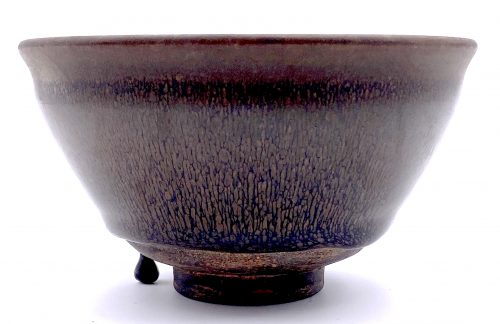 Brown bowl with golden-brown streaks on a black ground, mouth with a curved profile. A drop of glaze hanging in support. Base unglazed. In a wooden box. China, the Song dynasty [宋朝] (960 – 1279). Diameter: 12.5 cm; Height: 7 cm.
Brown bowl with golden-brown streaks on a black ground, mouth with a curved profile. A drop of glaze hanging in support. Base unglazed. In a wooden box. China, the Song dynasty [宋朝] (960 – 1279). Diameter: 12.5 cm; Height: 7 cm. -
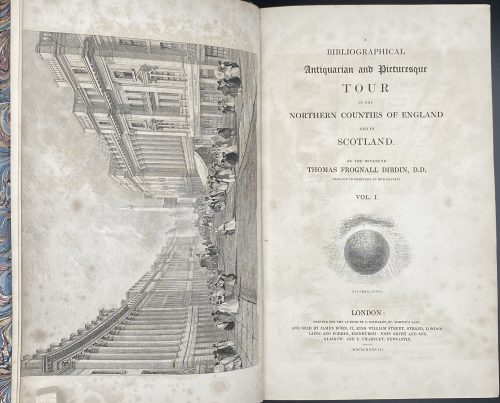 Vol. 1: A | BIBLIOGRAPHICAL | Antiquarian and Picturesque | TOUR | IN THE | NORTHERN COUNTIES OF ENGLAND | AND IN | SCOTLAND. | BY THE REVEREND | THOMAS FROGNALL DIBDIN, D.D. | CHAPLAIN IN ORDINARY TO HER MAJESTY. | VOL. I. |{device} motto: DEI OMNIA PLENA | LONDON: | PRINTED FOR THE AUTHOR BY C. RICHARDS, ST. MARTIN’S LANE : | AND SOLD BY JAMES BOHN, 12 KING WILLIAM STREET, STRAND, LONDON : | LAING AND FORBES, EDINBURGH : JOHN SMITH AND SON, | GLASGOW : AND E. CHARNLEY, NEWCASTLE. | MDCCCXXXVIII.|| Pagination: ffl, frontispiece by W. Douglas after T. M. Richardson, [i-ii] t.p. / blank; [iii-iv] - dedication to Frances Mary Richardson Currer (British, 1785 – 1861) / blank, [v] vi-xv – preface, [i] ii-xxx – supplement & index, [2] – corrections / colophon, [2] list of plates, [2] – contents, [1] 2-436, bfl; 11 plates extraneous to collation (incl. frontis.), lacking one plate (facing p. 213. “Thos. Bridges…”), in-text woodcut vignettes, head- and tailpieces. Collation: 8vo; π8 a-b8 [c2] B-Z8 2A-2E8 2F2. Vol. 2: Similar title but "VOL. II." Pagination: ffl, frontispiece portrait of Hugh Stewart, Aged 84 by Robert Bell after Alison (nothing known); [2] – t.p. / blank, [2] – contents / cont., [437-8] f.t. / blank [439] 440-1090, bfl; 453/4 misprinted 449/50; lacking list of subscribers. Collation: 8vo; π2 [2F3-2F6] 2G-2Z8 3A-3Z8. Binding: By J. Leighton, Brewer Street. Later half dark brown morocco over marbled boards, raised bands with gilt fillets, gilt titling and fillets in compartments, all edges gilt, marbled endpapers. Edition: 1st edition of Dibdin’s last major work and the only edition of this title. Size: 24.5 x 15.5 cm Provenance: Lord Ronald Gower (British, 1845 – 1916); Frank Hird (British, 1873 – 1937). Catalogue raisonné: Jackson 89; Windle & Pippin A65, pp. 179–188 [LIB-2669.2021]. Artists: Abraham, [I.] Frederic Henry (British, 1790 – 1845) Carmichael, James John Wilson (British, 1800 – 1868) Geikie, Walter (British, 1795 – 1837) Harraden, Richard Bankes (British, 1778 – 1862) Hill, David Octavius (British, 1802 –1870) McLea, John Watson (British, fl.1832-1861) Nixon, James Henry (British, b. c. 1808) Reynolds, Sir Joshua (British, 1723 – 1792) Richardson, Thomas Miles (British, 1784 – 1848) Scott, J. (British, fl. 19th c.) Wilkinson, T. M. (British, fl. 19th c.) Engravers: Aikman, Alison [spouse of George Aikman?] (British, 1788 – 1865) Bell, Robert Charles (British, 1806 – 1872) Byfield, Mary (British, 1794/5 – 1871) Douglas, William (British, 1780 – 1832) Harraden, F. (British, fl. 1838) Horsburgh, John (British, 1791 –1869) Johnstone, John (British, fl. 1835 – ) Leith & Smith, Lithogrs (Edinburgh) Lizars, William Home (British, 1788 – 1859) Miller, William (British, 1796 – 1882) Penny, William (British, fl. 19th c.) Prior, Thomas Abiel (British, 1809 – 1886) Robinson, H. (British, fl. 19th c.) Smith, Charles John (British, 1803 – 1838) Thomson, James (British, 1788 – 1850)
Vol. 1: A | BIBLIOGRAPHICAL | Antiquarian and Picturesque | TOUR | IN THE | NORTHERN COUNTIES OF ENGLAND | AND IN | SCOTLAND. | BY THE REVEREND | THOMAS FROGNALL DIBDIN, D.D. | CHAPLAIN IN ORDINARY TO HER MAJESTY. | VOL. I. |{device} motto: DEI OMNIA PLENA | LONDON: | PRINTED FOR THE AUTHOR BY C. RICHARDS, ST. MARTIN’S LANE : | AND SOLD BY JAMES BOHN, 12 KING WILLIAM STREET, STRAND, LONDON : | LAING AND FORBES, EDINBURGH : JOHN SMITH AND SON, | GLASGOW : AND E. CHARNLEY, NEWCASTLE. | MDCCCXXXVIII.|| Pagination: ffl, frontispiece by W. Douglas after T. M. Richardson, [i-ii] t.p. / blank; [iii-iv] - dedication to Frances Mary Richardson Currer (British, 1785 – 1861) / blank, [v] vi-xv – preface, [i] ii-xxx – supplement & index, [2] – corrections / colophon, [2] list of plates, [2] – contents, [1] 2-436, bfl; 11 plates extraneous to collation (incl. frontis.), lacking one plate (facing p. 213. “Thos. Bridges…”), in-text woodcut vignettes, head- and tailpieces. Collation: 8vo; π8 a-b8 [c2] B-Z8 2A-2E8 2F2. Vol. 2: Similar title but "VOL. II." Pagination: ffl, frontispiece portrait of Hugh Stewart, Aged 84 by Robert Bell after Alison (nothing known); [2] – t.p. / blank, [2] – contents / cont., [437-8] f.t. / blank [439] 440-1090, bfl; 453/4 misprinted 449/50; lacking list of subscribers. Collation: 8vo; π2 [2F3-2F6] 2G-2Z8 3A-3Z8. Binding: By J. Leighton, Brewer Street. Later half dark brown morocco over marbled boards, raised bands with gilt fillets, gilt titling and fillets in compartments, all edges gilt, marbled endpapers. Edition: 1st edition of Dibdin’s last major work and the only edition of this title. Size: 24.5 x 15.5 cm Provenance: Lord Ronald Gower (British, 1845 – 1916); Frank Hird (British, 1873 – 1937). Catalogue raisonné: Jackson 89; Windle & Pippin A65, pp. 179–188 [LIB-2669.2021]. Artists: Abraham, [I.] Frederic Henry (British, 1790 – 1845) Carmichael, James John Wilson (British, 1800 – 1868) Geikie, Walter (British, 1795 – 1837) Harraden, Richard Bankes (British, 1778 – 1862) Hill, David Octavius (British, 1802 –1870) McLea, John Watson (British, fl.1832-1861) Nixon, James Henry (British, b. c. 1808) Reynolds, Sir Joshua (British, 1723 – 1792) Richardson, Thomas Miles (British, 1784 – 1848) Scott, J. (British, fl. 19th c.) Wilkinson, T. M. (British, fl. 19th c.) Engravers: Aikman, Alison [spouse of George Aikman?] (British, 1788 – 1865) Bell, Robert Charles (British, 1806 – 1872) Byfield, Mary (British, 1794/5 – 1871) Douglas, William (British, 1780 – 1832) Harraden, F. (British, fl. 1838) Horsburgh, John (British, 1791 –1869) Johnstone, John (British, fl. 1835 – ) Leith & Smith, Lithogrs (Edinburgh) Lizars, William Home (British, 1788 – 1859) Miller, William (British, 1796 – 1882) Penny, William (British, fl. 19th c.) Prior, Thomas Abiel (British, 1809 – 1886) Robinson, H. (British, fl. 19th c.) Smith, Charles John (British, 1803 – 1838) Thomson, James (British, 1788 – 1850)


